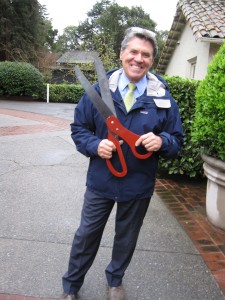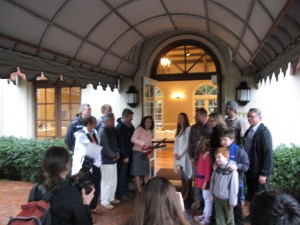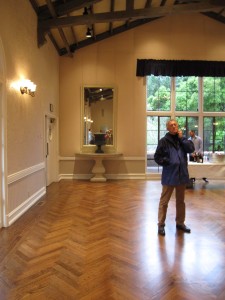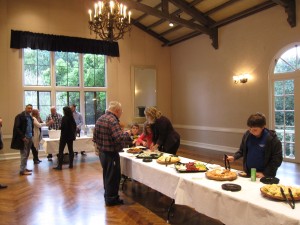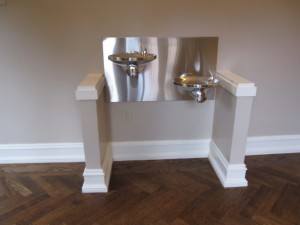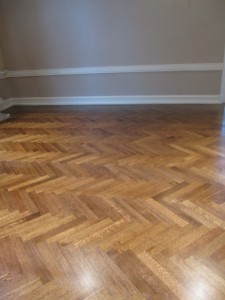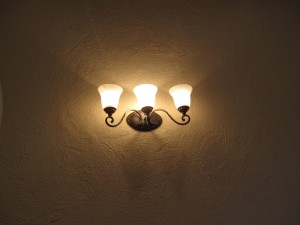Mar 10 2016
As this website is dedicated to civic affairs, readers may want to take notice of an interesting example of civic process playing out in City Hall right now.
At a public hearing of the Park Commission to address 10-grader Milo Gaillard’s petition to open the upper lawn in Dracena Park to off-leash dog use, a Dracena Avenue neighbor opposed to the petition introduced a map showing that the current off-leash areas of the park are in contradiction to the intent of the 1974 Council resolution establishing the dog run. A subcommittee was established to evaluate the petition but also took up the question of the validity of the current off-leash areas.
The subcommittee returned a report with little analysis of the feasibility of the petition but rather with a detailed analysis of the “legislative history” of the Dracena off-leash rules concluding that the current off-leash use of the park is “not consistent” with City Code. The subcommittee report offered the following history as justification for its conclusion (emphasis added):
· In 1970, the Council added a requirement to the City Code that dogs in public areas be on leash. Previously dogs could be off-leash, but had to be “at heel.”
· In 1974, the Council amended the Code provision that dogs be on leash and allowed the Council, by resolution, to set off-leash areas. At that time, the Council designated four off-leash areas: Blair Park, Piedmont Park creek area, Dracena Park Pathway, and Linda Park.
· In 1993, the City Council, by resolution, adopted the recommendations of the Park Commission regarding off-leash dogs in Dracena Park for a one year trial period.
· In 1997, Council by Ordinance 569 N.S., consolidated many different provisions in the City Code relating to parks into a single chapter. This included defining the off leash areas originally established by resolution in 1974 into the City Code.
· In 2000, the Council refined the definition of the off-leash areas, added rules for dogs using these areas, and added the requirement that dogs using off leash areas have a special license.
The subcommittee history leaves out important facts about the adoption and implementation of the Dracena Park off-leash rules (emphasis added):
~~~~~~First, from Piedmont Municipal Code, Chapter 4, “Animals”, 1989:
“Sec. 4.13 Running at Large.
It shall be unlawful for any person owning or having in charge, care, control or custody any dog to suffer or permit any such dog to trespass on private property. As an exception to this section, the City Council shall by resolution designate specific areas within the City in which any dog under the control of a competent person may be permitted to run without being secured by a rope, chain or other leash; provided that at no time shall a dog in such specified areas be further than fifty yards distance from the competent person controlling such dog or be allowed to threaten, intimidate, bite or endanger any person in such specified areas; provided further, that the City Council may by resolution from time to time set forth specific times or days in such designated areas during which no dog may be permitted to run without being secured by a rope, chain or other leash not over six feet in length. (Ord. No. 291 N.S., ‘1; Ord. No. 316 N.S.,’1)”
~~~~~~~ from Ordinance 569 N.S, 1997:
3.4.2 Dog Runs Established. The following areas, which are illustrated on maps incorporated into this chapter, are designated as “dog runs” and dogs under the control of a competent person shall be exempt from the provisions of Section 4.13 of the municipal code when in these areas.
a. Blair Park in it entirety
b. Piedmont Park creek area from the rear of the Community Hall to the Wildwood playground
c. Dracena Park pathway from Dracena Avenue to ArtunaAvenue
d. Linda Park loop and upper path
3.4.3 Dog Run Signs Required. The Department of Public Works shall be responsible for installation and maintenance of signs in all dog runs which clearly designate the area to be used by dogs off leash.
~~~~~~From the minutes of City Council, November 6, 2000:
City Council Action
After a large amount of public testimony on the ordinance, the Council approves the first reading of Ord. 619 N.S. making changes Sec. 3.4 of the City Code (Dogs in Parks) (Resolution 73-00) as follows: (New text is underlined and text to be removed is in strikeout)
Section 3.4.2 is amended to read:
“The following areas, which are illustrated in maps incorporated is this chapter are designated as “dog runs” and dogs under the control of a competent person shall be exempt of the provisions of Section 4.13 of the municipal code when in these areas.
1. Blair Park in its entirety
2. Piedmont Park creek area (designated by signs)from in the rear of the Community Hall to the Wildwood playground Piedmont Unified School District Property Line
3. Dracena Park pathway (designated by signs) from Dracena Avenue to Artuna Avenue
4. Linda Park loop and upper path (within fenced off-leash area).
Section 3.4.3 is amended to read:
“The Department of Public Works shall be responsible for installation and maintenance of signs in all off leash areas which clearly designate the area to be used by dogs off leash and the rules for off leash areas as established in Section 3.4.4 of this Code.”
With this additional history, especially the definition of off leash dogs in Chapter 4 that allows dogs to be within 50 yards of their owner, the current off leash use of Dracena Park is completely consistent with City Code.
Under the definition of off-leash in Chapter 4, all of upper Dracena Park is off-leash dog run, being within 50 yards of the Dracena-Artuna pathway.
In this context, the 1993 trial period allowing dogs on the upper pathway was a reduction of the off-leash area of the park and Milo’s petition, rather than a request for a new use, seeks restoration of what was once allowed.
Even without Chapter 4, the history supports the intent of City Council to expand the off-leash use of the park from the 1974 resolution to what it is today. In Ordinance 569, City Council established the authority of the Public Works Department to designate with signs the area to be used by dogs off-leash and current signage in place for over 20 years supports that.
In 2000, Council explicitly removed references to a trails map and again reiterates the role of Public Works to designate the areas and rules for off leash dog use. In Dracena Park, staff implementation is clearly evident by signage which designates upper and lower pathways as off -leash and the lawn as on-leash.
So here’s the civics question: does a single word from the 1974 resolution, “pathway”, trump 30 years of Council action and city administration to the contrary? Are off-leash dogs that wander off the pathway “inconsistent” with City Code or do the signs throughout the park define the off leash area?
It’s the classic example of the “original vs. living” document debate of Justices Scalia and Breyer at the U.S. Supreme Court! OK, that may be a stretch as we are talking about a 10th-grader’s “simple” petition to let dogs on the lawn. But the consequences to dog owners are serious.
The Park Commission is recommending a 50% reduction in the use of the upper half of the dog run, the section most used by dog owners, especially seniors.
Now, Council will take up this “great debate” at its March 21 meeting. Will it continue with this can of worms and reopen this contentious issue or will it honor past Council direction and maintain staff’s discretion to manage the off leash areas? In that regard, the Council might want to consider some advice Milo has been hearing from City Hall – be careful what you ask for.
With a pending ballot initiative to increase the parcel tax, will it reduce off-leash use of Dracena Park, one of the most popular municipal services provided for by the tax?
Garrett Keating, Former Piedmont Councilmember
Editors’ Note: Opinions expressed are those of the author.



